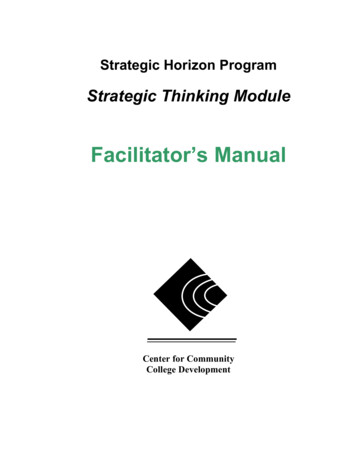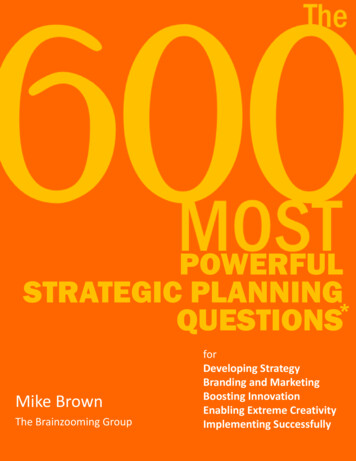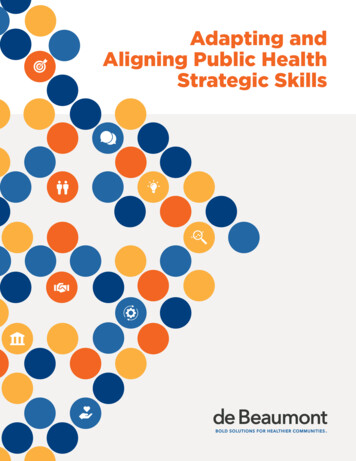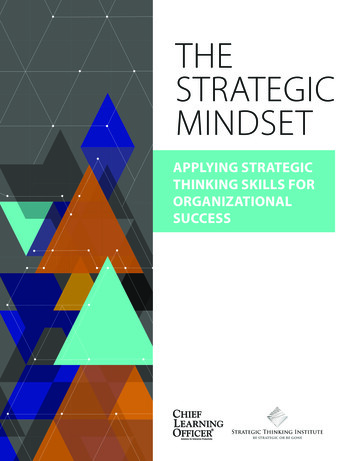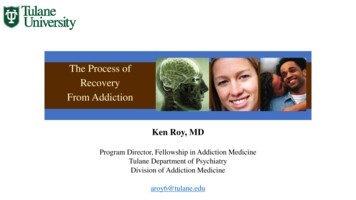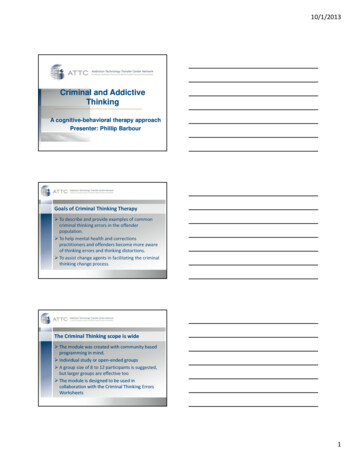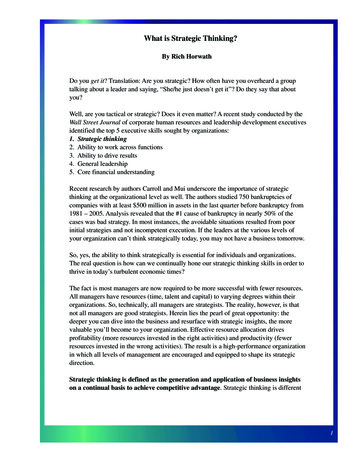
Transcription
!!What is Strategic Thinking?By Rich HorwathDo you get it? Translation: Are you strategic? How often have you overheard a grouptalking about a leader and saying, “She/he just doesn’t get it”? Do they say that aboutyou?Well, are you tactical or strategic? Does it even matter? A recent study conducted by theWall Street Journal of corporate human resources and leadership development executivesidentified the top 5 executive skills sought by organizations:1. Strategic thinking2. Ability to work across functions3. Ability to drive results4. General leadership5. Core financial understandingRecent research by authors Carroll and Mui underscore the importance of strategicthinking at the organizational level as well. The authors studied 750 bankruptcies ofcompanies with at least 500 million in assets in the last quarter before bankruptcy from1981 – 2005. Analysis revealed that the #1 cause of bankruptcy in nearly 50% of thecases was bad strategy. In most instances, the avoidable situations resulted from poorinitial strategies and not incompetent execution. If the leaders at the various levels ofyour organization can’t think strategically today, you may not have a business tomorrow.So, yes, the ability to think strategically is essential for individuals and organizations.The real question is how can we continually hone our strategic thinking skills in order tothrive in today’s turbulent economic times?The fact is most managers are now required to be more successful with fewer resources.All managers have resources (time, talent and capital) to varying degrees within theirorganizations. So, technically, all managers are strategists. The reality, however, is thatnot all managers are good strategists. Herein lies the pearl of great opportunity: thedeeper you can dive into the business and resurface with strategic insights, the morevaluable you’ll become to your organization. Effective resource allocation drivesprofitability (more resources invested in the right activities) and productivity (fewerresources invested in the wrong activities). The result is a high-performance organizationin which all levels of management are encouraged and equipped to shape its strategicdirection.Strategic thinking is defined as the generation and application of business insightson a continual basis to achieve competitive advantage. Strategic thinking is different1
than strategic planning. Strategic planning is the channeling of business insights into anaction plan to achieve goals and objectives. A key distinction between strategic thinkingand strategic planning is that the former occurs on a regular basis, as part of our dailyactivities, while the latter occurs periodically (quarterly, semi-annually or annually).Unlike the additional work that is created by the process of strategic planning, we canunderstand strategic thinking as using a new lens to view the business. It’s not aboutadding more work. It’s about enhancing the view of the work and improving one’s abilityto perform it.You’ve likely noticed during your daily encounters with bosses, colleagues, directreports, customers, suppliers, and other individuals that strategic thinking comes invarying degrees, ranging from brilliant to nonexistent. To hone in on one’s ability to thinkstrategically, I have taken the results of research I conducted among senior managersfrom 154 companies and have identified four types of strategic thinkers. These will helpyou better understand how to think strategically and will give you insight into individualsin your organization. Two criteria to consider as you evaluate an individual’s ability toprovide strategic insight are the “Impact of Insights” and the “Frequency of Insights.”Using the analogy of underwater diving, there are four types of strategic thinkers. Thefirst type is the Beach Bums. Like a beach bum, this manager mentally lounges aroundand doesn’t really contribute any insights to the business. The second type of strategicthinker is the Snorkeler. This type of manager skims the surface of issues. They’re thefirst one to wave their hand in the air and say, “We have a problem” but don’t offer anypotential solutions. The third type of strategic thinker is the Scuba Diver. Like a scubadiver, when these managers are equipped with the right tools and instruction, they cancome up with strategic insights. The final type of strategic thinker is the Free Diver. Afree diver can dive underwater to depths of 800 feet on a single breath. These managersgenerate new and impactful ideas for the business on a regular basis. The research showsonly three out of every ten managers are highly strategic, or at the Free Diver level.The reality is most people can’t hold their breadth for more than one minute. But, theworld record for a free diver holding his breadth is 11 minutes and 35 seconds! So why isthere such a big difference? Free divers have learned and practiced the key breathingtechniques. They’ve learned how to use their resource, oxygen, more effectively than therest of us. In business, resources consist of time, people and money. Strategic thinking ishow effectively you use these resources relative to the competition in serving customers.At first blush, it would appear that the only things standing in a manager’s way ofbecoming a Free Diver are adequate knowledge and tools to think strategically on aregular basis. While these do account for a large portion of the cases, a subtler reason alsoexists. Strategic thinking, and the actions taken to follow through on it, requires anappetite for risk. Strategy calls for focus and the trade-offs that inherently follow, butmany managers decide they would rather play it safe. In most organizations, sins of2
commission—taking a risk and failing—are punished much more harshly than sins ofomission—not taking a risk and missing out on a great opportunity. With both political(your reputation within the company) and career (not wanting to jeopardize your nextpromotion) ramifications to consider, many managers consciously opt out of strategicthinking. And that’s a shame. As Roberto Goizueta, the successful former CEO of CocaCola, points out: “If you take risks, you may still fail. If you do not take risks, you willsurely fail. The greatest risk of all is to do nothing.”To maximize your resources and profitably grow the business on a consistent basis, thereare three disciplines of strategic thinking you can develop to continually ground yourbusiness in solid strategy:1. Acumen: generating key business insights.2. Allocation: focusing resources through trade-offs.3. Action: executing strategy to achieve goals.Discipline #1: AcumenOne of the interesting paradoxes of strategy is that in order to elevate one’s thinking tosee “the big picture,” one must first dive below the surface of the issues to uncoverinsight. A strategic insight is a new idea that combines two or more pieces of informationto affect the overall success of the business and lead to competitive advantage. An icebergillustrates a universal phenomenon when it comes to insights. If the iceberg represents thebody of insights for a particular market, all too often companies battle one another usingthe insights represented by the tip of the iceberg. Above the surface of the water and inplain sight for everyone, these insights require no extra effort to acquire, and offer thepath of least resistance to those too lazy to do any real thinking. Since they are readilyavailable to the entire market, they quickly lose value when it comes to developing astrategy steeped in the differentiation required to gain competitive advantage.Hidden below the surface are insights represented by the largest portion of the iceberg.The large size of the underwater portion doesn’t indicate a large number of insights.Instead, this larger portion indicates the greater effect of these insights on the business ifthey are unleashed.Acumen Question: What is the key insight driving this initiative, project or activity?Discipline #2: AllocationWhile it’s one thing to have a neatly written strategy on paper, the truth is the actual orrealized strategy of an organization is a result of the resource allocation decisions madeby managers each day. Therefore, it is critical to have a firm understanding of resourceallocation and how to maximize its potential for your organization. With multi-billiondollar companies such as United Airlines and General Motors going through bankruptcy,it’s obvious in today’s market that having the most resources guarantees nothing. It’s howwe allocate resources that truly matters.3
Once the insights have been generated through the Acumen discipline, one has the keyingredient in making resource allocation decisions. The definition of strategy begins with“The intelligent allocation of limited resources ”. Resource allocation is at the core ofstrategy. Discussions of strategy boil down to how to allocate limited resources tomaximize business potential.Allocation Question: What trade-offs will I make to focus resources?Discipline #3: ActionIt’s often assumed that once a sound strategy has been formulated, the execution of thatstrategy will take care of itself. Research seems to indicate otherwise. A survey of morethan 400 companies published in Training & Development Magazine showed 49 percentof business leaders report a gap between their organization’s ability to articulate astrategic vision and their effectiveness in executing that vision. Additionally, 64 percentof executives did not believe their organization had the ability to close that gap. Theeffective action or execution of strategy involves the discipline to focus on the importantissues, not the urgent ones filling up our email In Box.Action Question: What actions can I take to achieve advantage?As you build these three disciplines of strategic thinking into your mindset and behavior,there are three common traps to avoid:Trap #1: AnchorsIn making decisions, the mind tends to give initial information or impressions adisproportionate amount of weight. This tendency is referred to as an “anchor.” Theanchor jades the decision-making process because it starts the process at an artificiallyhigh or low point. Numerous studies have shown when an anchor is used at the beginningof the decision-making process, people do not sufficiently adjust from that initial anchorvalue to a more accurate one. A study of real estate appraisers and the effects ofanchoring showed that by changing only one piece of information (the listing price) in aten-page package of materials, the researchers were able to shift the real estate appraisalby more than 10,000.Most commonly, anchors take the form of last year’s strategic plan or this year’s budget.By using the assumptions that went into last year’s plan, strategy becomes fatally flawed.Strategic thinking demands that all assumptions, beliefs and information are looked atfrom a fresh perspective on a continual basis. Simply tweaking last year’s plan is a majordisservice to one’s business because it suffocates any chance of discovering new insightsthat may dramatically alter the strategic direction.Anchor’s Away: To avoid the danger of anchors in strategic thinking, consider thefollowing: Create an open mind by actively considering the range of starting points available, notjust the anchor point (i.e., budget numbers).4
Identify anchors as soon as they appear and call them out mentally and physically (onpaper/flipchart) so everyone is aware of their presence.Trap #2: GroupthinkAs strategic thinking and strategic planning are often done in a group setting, it’simportant to recognize the influence of “groupthink.” Groupthink occurs when there is ahomogenous group of people with little influence from outside sources and a high levelof pressure to conformity. Groupthink tends to directly and indirectly reduce the level ofobjective thinking, remove “devil’s advocate” thinking and punish those who attempt todo either. Irving Janis describes eight symptoms of groupthink. As you participate in yourgroup’s next strategic thinking or planning session, try to observe if any of thesesymptoms are present:1. Illusion of invulnerability that leads to over-optimism and excessive risk-taking.2. Efforts to rationalize or discount warning signs.3. No challenges to collective thinking.4. Stereotyped views of competitors as inconsequential.5. Pressure on group members that disagree with the majority.6. Shared illusion of unanimity.7. Self-correction when thinking of diverting from group consensus.8. Seek information that supports group consensus and unwillingness to look for orconsider information that is contrarian (also known as the “confirming evidence bias”).Group(Think) Therapy: To avoid the danger of groupthink in strategic thinking,consider the following: Utilize an external resource to facilitate the strategy session to ensure objectivity anddivergent opinions. Bring in people from other functional areas (R&D, IT, HR) to offer differentperspectives.Trap #3: Status QuoPopular adages such as “If it ain’t broke, don’t fix it,” “Don’t rock the boat,” and “Letsleeping dogs lie” all feed into the natural tendency to prefer the status quo. Time andagain, research has proven when individuals have the option of doing something new orstaying with the status quo, they overwhelmingly stay with the status quo.Feeding into the danger of always leaning toward the status quo is that fact that humanbeings are generally risk-averse. Research in the field of decision-making by AmosTversky and Daniel Kahneman has shown the threat of a loss has a greater effect on adecision than the possibility of an equivalent gain. The response to loss is more extremethan the response to gain. Consequently, many strategy decisions place too much weighton the potential negative outcomes or threats. This principle of human nature has a strongeffect on strategy decisions and must be taken into account to avoid always acting in arisk-averse manner when the probability of success is actually greater.5
Turning the Status Quo into Dough: To avoid the danger of the status quo in strategicthinking, consider the following: Focus on the outcome desired and use that as a measurement between the status quo andother alternatives. Examine the actual changes that would need to be made to abandon the status quo, asthe reality is often less painful then imagined.Most books and training programs only address the first three levels of strategy:corporate, business unit and functional group. In reality, these are all subsets of the mostimportant level of strategy: YOU. The individual level is where strategy is actuallycreated. Unfortunately, 90% of directors and vice presidents have never had any learning& development opportunities on strategic thinking. The good news is that by developingthe three disciplines of strategic thinking, you can elevate yourself from tactical tostrategic. The better news is that in doing so, not only will you become more valuable toyour organization, you’ll separate yourself and your business from the competition. Doyou get it?Rich Horwath is an author, professor, strategist and speaker who helpsmanagers think strategically to create competitive advantage. He is the presidentof the Strategic Thinking Institute, a former Chief Strategy Officer and author offour books, including Deep Dive: The Proven Method for Building Strategy. Visitwww.strategyskills.com to sign-up to receive your free copy of Strategic Thinker.6
identified the top 5 executive skills sought by organizations: 1. Strategic thinking 2. Ability to work across functions 3. Ability to drive results 4. General leadership 5. Core financial understanding Recent research by authors Carroll and Mui underscore the importance of strategic thinking at the organizational level as well.File Size: 1004KBPage Count: 6
